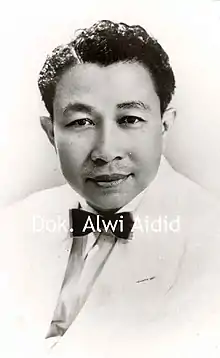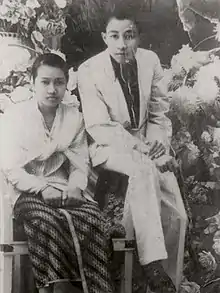Husein Aidid
Husein Aidid (Arabic: حسين عيديد, romanized: Ḥusayn ʻAydīd, Arabic pronunciation: [ħuˈsajn ?ajdi:d]; born 1913) was an Indonesian songwriter, singer and entrepreneur. Aidid was the founder and leader of the Orkes Gambus al-Usysyaaq (founded in 1947[1]) which later became transformed into the Orkes Melayu Kenangan in 1950.[2] Together with his new Malay Orchestra, on October 26, 1950, Aidid began its first broadcast on Radio Republik Indonesia and was broadcast nationally. At that time, RRI was the most popular entertainment facilities of society.[3]
Husein Aidid حسين عيديد | |
|---|---|
 Husein Aidid | |
| Background information | |
| Birth name | Husein |
| Born | 1913 Pekojan, Tambora, Jakarta |
| Origin | Jakarta, Indonesia |
| Died | September 13, 1965 (aged 51–52) Tanah Abang, Central Jakarta |
| Genres | Gambus |
| Occupation(s) |
|
| Instrument(s) |
|
| Years active | 1947–1962 |
| Labels | Bali record |
| Past members |
|
| Website | huseinaidid |
Aidid died in September 13, 1965.
Biography
Early life
Aidid was born in an Arab village in Pekojan, West Jakarta in 1913. He came from the family of Ba 'Alawi sada of Arab Hadhrami descent surnamed Aidid (Arabic: عيديد, romanized: ʻAydīd, Arabic pronunciation: [?ajdi:d]), his father was Alwi bin Abubakar Aidid, while his mother was a Betawi girl named Fatimah.[4] He studied at Kampong Djawa-Batavia Centrum School, majoring in Metalworking.[5]
Career
Early career
Since young, Aidid has been wrestling with the music world. He studied music to Sardi, the father of a legendary violinist Idris Sardi. The instruments he used to play were piano and violin. With his piano he could create and orchestrate a song, then poured in a special music book.[6]

Gambus orchestra
In 1947, Aidid along with other Pekojan youths founded a gambus orchestra named al-Usysyaaq, with Aidid as its leader. Although at the beginning of the emergence of this gambus orchestra has not been able to penetrate Radio Republik Indonesia, but the performance of the gambus orchestra unexpectedly got a good response from the people of Jakarta who, at that time, were fond of the Malay rhythmic songs, like qanbūs music.[1]
References
- Shahab 2004, p. 25.
- Weintraub, Andrew N., 2010, p. 43.
- Shahab 2004, p. 26.
- Aidid, Alwi (October 28, 2008). "Riwayat Hidup Husein Aidid" [Curriculum Vitae of Husein Aidid]. Husein Aidid (in Indonesian). Archived from the original on May 11, 2018. Retrieved May 11, 2018.
- Aidid, Alwi (November 29, 2008). "Mengenal Husein Aidid" [Get to know Husein Aidid]. Husein Aidid (in Indonesian). Archived from the original on May 11, 2018. Retrieved May 11, 2018.
- Shahab 2004, p. 27.
Bibliography
- Sakrie, Denny (March 25, 2015). 100 Tahun Musik Indonesia [100 Years of Music of Indonesia] (in Indonesian). Jakarta: Gagas Media. ISBN 978-9797807856.
- Shahab, Alwi (2004). Saudagar Baghdad dari Betawi [Baghdad Merchant from Betawi] (in Indonesian). Jakarta: Republika publisher. ISBN 9793210303.
- Weintraub, Andrew N. (August 26, 2010). Dangdut Stories: A Social and Musical History of Indonesia's Most Popular Music. Oxford: Oxford University Press. ISBN 9780199780235.
- Jakarta provincial government (January 1, 2018) [first published 2005 (as book version)]. "Aidid, Husein" [Husein Aidid]. Ensiklopedi Jakarta: Culture & Heritage (in Indonesian). Vol. 3 (Online ed.). Jakarta: Department of Culture and Museum of Jakarta Special Region Provincial Government. ISBN 9789798682490. Archived from the original on June 2, 2017. Retrieved May 11, 2018.
- Weintraub, Andrew (2010). "Music and Malayness: Orkes Melayu in Indonesia. 1950–1965" (PDF). Musiques d'un Archipel. Paris: Institut national des langues et civilisations orientales. 79 (2): 57–78. doi:10.3406/arch.2010.4160.